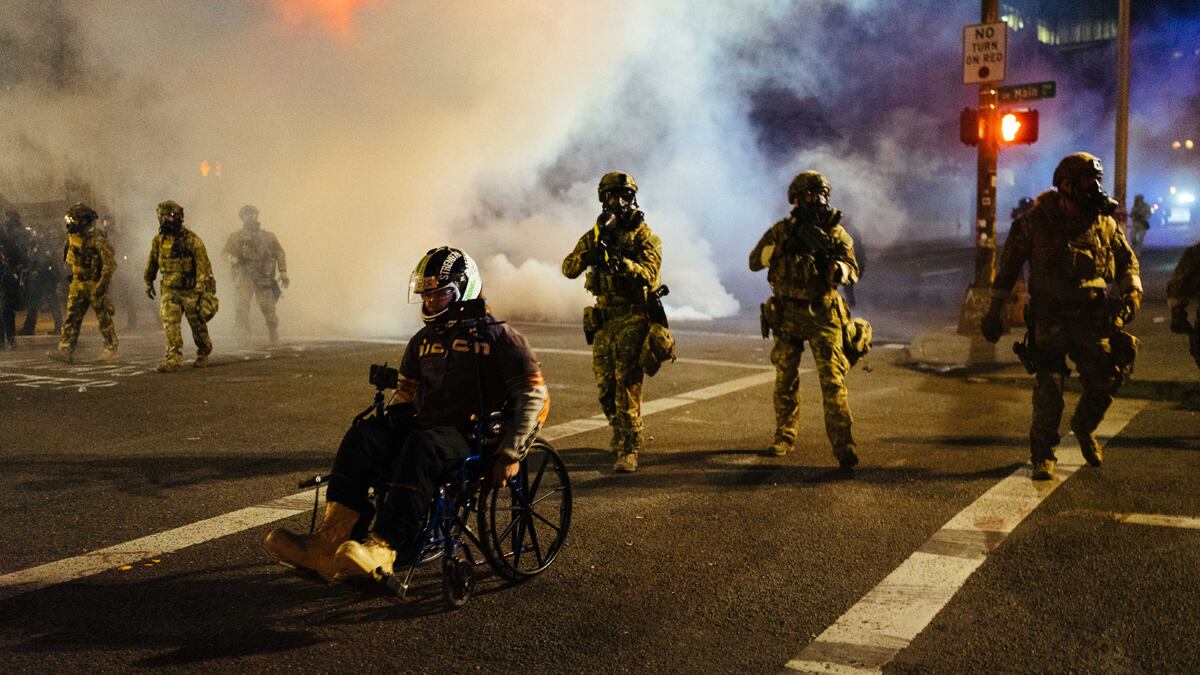Americans are watching in horror at what President Trump's police are doing to Portlanders.
Since they arrived here July 2, federal officers have snatched at least two Portland protesters off the streets and driven them away in unmarked rental vans, deployed tear gas indiscriminately and without warning, shot a protester in the head with a munition resulting in an injury requiring facial reconstructive surgery, and beaten dozens of people with batons.
Trump sent officers from four federal agencies to quash street protests in a city that despises him. Instead, their actions have inspired national outrage, and galvanized Portlanders back into the streets by the thousands. Nearly every elected official in the state is looking for a way to show they oppose the occupying force—or, if they oversee a police department, to distance themselves from the federal cops.
At the same time, it's obvious that some collaboration has occurred between Portland cops and federal police. When the two agencies worked in tandem to clear protesters last weekend, that set off a volley of accusations inside City Hall about the complicity of the local police with federal actions. "The Portland Police Bureau has collaborated with federal occupiers," City Commissioner Chloe Eudaly wrote July 20.
It remains unclear whether, and to what extent, the two agencies continue to coordinate. But what Eudaly and others are implying is that federal police are doing Portland cops' dirty work—using brutal tactics that local agencies would struggle to get away with in this politically fraught moment.
And it's certainly true that the feds follow orders from a boss who is much more keen on penalizing protesters than local agencies: Department of Homeland Security Acting Secretary Chad Wolf said during a July 21 press conference that Portland is overrun by "violent anarchists" who must be quelled. The feds aren't beholden to the same protocols as the Portland Police Bureau. Instead, federal agents follow the directives outlined in their respective rulebooks, which sometimes offer more leeway in determining things like probable cause, or reaching the threshold of "imminent danger" when employing deadly use of force.
"Our local law enforcement is on a tighter leash, so to speak, because they have two constitutions to follow," says Portland criminal defense lawyer John Schlosser.
WW examined a half-dozen tactics that we've observed federal police use in the past week, or that have been alleged on the record by protesters. Some of these tactics are legal for the feds, but not for local police. Others are available to both.
Even when police overstep, it's difficult to stop them.
"These are your rights, but it's not necessarily in play while it's happening," says Juan C. Chavez, a lawyer with the Oregon Justice Resource Center. "It's like fighting a shark: The shark makes the rules."

TACTICS USED BY POLICE SINCE FEDS ARRIVED
Deploying tear gas without warning
Is it legal? Yes, for the feds. Last month, the Oregon Legislature passed House Bill 4208, which prohibited the use of tear gas except in riots. Oregon law enforcement agencies now must give two warnings before deploying the chemical agent. That's what they've done since the law passed in June. But the law doesn't apply to federal agencies. On multiple occasions, federal law enforcement agents have deployed CS gas without any warning.
Pulling people into unmarked vans
Is it legal? Maybe. This tactic, alleged on two occasions, has garnered nationwide attention. Oregon Public Broadcasting first reported that a protester named Mark Pettibone was pulled into an unmarked van July 15 and taken to the federal courthouse. The incidents, dubbed the "Portland kidnappings," are alarming. But federal agents can technically detain a person if they have probable cause, and transport them in an unmarked vehicle. "It isn't of itself illegal, necessarily," Chavez says. "But in the totality of what we know about that practice, we've seen legal objections."
Not providing a lawyer to a detainee
Is it legal? Maybe. Pettibone says he was taken to the Mark O. Hatfield U.S. Courthouse, where he refused to answer questions without a lawyer present, and the officers let him go. Another protester, Juniper Simonis, was arrested July 10 while drawing with chalk near federal property downtown. Detained for several hours, Simonis asked for an attorney multiple times but was not provided one, nor were they given access to a phone to contact an attorney. Simonis declined to answer questions without an attorney present, and they were released hours later.
Schlosser says law enforcement must provide a detainee with a lawyer during questioning if the detainee requests one: "If you're asking questions prior to having charges filed, you have the right to have an attorney present." If the feds don't provide people with lawyers, they can't use any statements detained people give. That might provide a clue why federal prosecutors haven't filed any criminal charges against protesters since July 13.
Detaining protesters in non-judicial buildings
Is it legal? Yes. Simonis says they were detained for several hours in the basement of the Edith Green-Wendell Wyatt Federal Building downtown. It's not a jail or a courthouse. But law enforcement is allowed to use any building as a jail. "A jail is anywhere they hold you pretrial," Chavez says.

TACTICS USED BY POLICE BEFORE FEDS ARRIVED
Using batons on protesters
Is it legal? Yes. A July 18 now-viral video shot by Portland Tribune reporter Zane Sparling shows federal agents strike Navy veteran Chris Davis at least five times with a baton outside the Mark O. Hatfield federal courthouse. This is a crowd control technique that police—local and federal—use frequently when scattering or arresting protesters. However, federal agents attacked Davis in a more aggressive manner than is usually employed by local police, who typically use batons to force protesters forward, rather than using them like baseball bats as the feds have done. Chavez says the manner in which police hit Davis may violate federal rules. "The baton strikes we've seen from DHS looks more like martial arts," Chavez says.
Covering ID badges
Is it legal? Yes. Federal agents can cover their identification badges. But a new bill put forth by Oregon Sen. Jeff Merkley seeks to require them to "at all times display identifying information in a clearly visible fashion," including the agency they work for, their last name or a unique identifier, and rank. That would make them subject to tougher rules than the Portland police, who currently cover their badges, fearing "doxxing" of their identities.
Using force on reporters
Is it legal? No, but the rules are toothless. It is a violation of the First Amendment to use force on members of the press covering protests. But in several incidents, Portland reporters identified themselves as media, and cops hit them anyway. A federal judge in Oregon, Michael H. Simon, filed an injunction earlier this month prohibiting Portland police from using force on journalists after the American Civil Liberties Union of Oregon sued. To use such force would mean Portland police were acting in contempt of court. However, the injunction applies only to local police—not the feds, for now. (The ACLU of Oregon levied a similar lawsuit against federal agents July 17. It is still pending.) On July 19, federal agents injured multiple reporters, including Donovan Farley and Alex Milan Tracy—both with less-than-lethal munitions.

